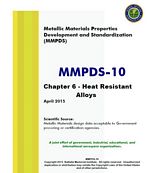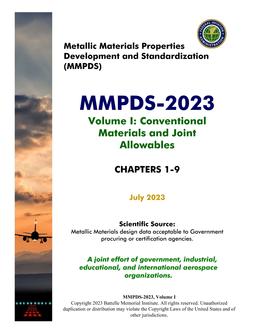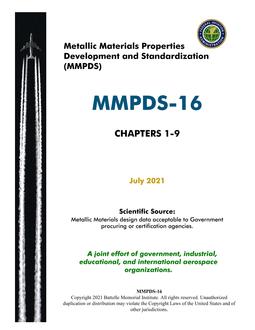
Click here to purchase
The Metallic Materials Properties Development and Standardization (MMPDS) Handbook, is an accepted source for metallic material and fastener system allowables recognized by the Federal Aviation Administration (FAA), all Departments and Agencies of the Department of Defense (DoD), and the National Aeronautics and Space Administration (NASA) within the limitations of the certification requirements of the specific government agency.
Heat-resistant alloys are arbitrarily defined as iron alloys richer in alloy content than the 18 percent chromium, 8 percent nickel types, or as alloys with a base element other than iron and which are intended for elevated-temperature service. These alloys have adequate oxidation resistance for service at elevated temperatures and are normally used without special surface protection. So-called “refractory” alloys that require special surface protection for elevated-temperature service are not included in this chapter.
This chapter contains strength properties and related characteristics of wrought heat-resistant alloy products used in aerospace vehicles. The strength properties are those commonly used in structural design, such as tension, compression, bearing, and shear. The effects of elevated temperature are presented. Factors such as metallurgical considerations influencing the selection of metals are included in comments preceding the specific properties of each alloy or alloy group. Data on creep, stress-rupture, and fatigue strength, as well as crack-growth characteristics, are presented in the applicable alloy section.
There is no standardized numbering system for the alloys in this chapter. For this reason, each alloy is identified by its most widely accepted trade designation.
For convenience in presenting these alloys and their properties, the heat-resistant alloys have been divided into three groups, based on alloy composition. These groups and the alloys for which specifications and properties are included are shown in Table 6.1.
The heat treatments applied to the alloys in this chapter vary considerably from one alloy to another. For uniformity of presentation, the heat-treating terms are defined as follows:
- Stress-Relieving – Heating to a suitable temperature, holding long enough to reduce residual stresses, and cooling in air or as prescribed.
- Annealing – Heating to a suitable temperature, holding, and cooling at a suitable rate for the purpose of obtaining minimum hardness or strength.
- Solution-Treating – Heating to a suitable temperature, holding long enough to allow one or more constituents to enter into solid solution, and cooling rapidly enough to hold the constituents in solution.
- Aging, Precipitation-Hardening – Heating to a suitable temperature and holding long enough to obtain hardening by the precipitation of a constituent from the solution-treated condition.
The actual temperatures, holding times, and heating and cooling rates used in these treatments vary from alloy to alloy and are described in the applicable specifications.
Product Details
- Edition:
- 10
- Published:
- 04/01/2015
- Number of Pages:
- 270
- File Size:
- 1 file , 28 MB
- Part of:
- MMPDS MMPDS-10


